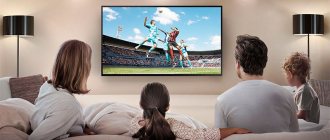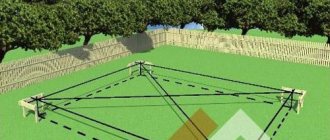The TV diagonal is the distance between two opposite corners of the display.
The size of the picture and the ease of viewing it depend on the diagonal. The larger the diagonal, the more comfortable it is to watch TV. But it should be borne in mind that large screens are not suitable for solving household tasks: for games, watching movies, photos, for the Internet. How to choose the TV diagonal. In terms of screen size, TVs with diagonals of 33-42 inches (approximately 80-120 cm) are now leading. Diagonal sizes smaller than 32 inches are rare, but such models still exist. As a rule, these are compact TVs. To connect a computer or laptop to them you will need a special device - a TV tuner.
How to convert the diagonal size of a TV screen from inches to centimeters and back
The diagonal of a TV screen, and equipment in general, is measured in inches. This happened due to the use of this length measurement in the countries with the greatest demand for household appliances. When converted to centimeters, 1 inch of TV diagonal is equal to 2.54 centimeters. Also, on household appliances, when indicating the diagonal in inches (to avoid confusion), a double stroke (“) is used after the screen length or other measurements (height, width, length).
- 1 inch = 2.54 centimeters = 25.4 millimeters
- 1 centimeter = 0.3937 inches
- 1 meter = 39.37 inches
Table of TV screen diagonals in inches and centimeters
To convert inches to centimeters and vice versa when calculating the diagonal of a TV, use the following table for the most common TV screen sizes:
| In inches | In centimeters |
| 22″ | 55.88 cm. |
| 32″ | 81.28 cm. |
| 37″ | 93.98 cm. |
| 40″ | 101.60 cm. |
| 42″ | 106.68 cm. |
| 46″ | 116.84 cm. |
| 50″ | 127.00 cm. |
| 55″ | 139.70 cm. |
| 60″ | 152.40 cm. |
| 70″ | 177.80 cm |
TV with parameters 55”
Samsung UE55NU7300UXRU
LCD TV with EDGE backlight and curved screen to create the illusion of complete immersion for the viewer.
The screen expansion complies with modern standards: 4K UHD. In addition, the device supports HDR technology, which allows you to process video in a wide dynamic range. UE55NU7300UXRU is a smart TV with built-in Wi-Fi and two TV tuners.
The most popular TV screen sizes
When selecting a TV, you need to be attentive to the manufacturer’s method of measuring the diagonal of the TV screen, since each manufacturer interprets the diagonal differently: for example, most manufacturers consider the TV diagonal to be the exclusively useful part of the screen. Some other manufacturers consider the TV diagonal to be the actual size of the body.
If we are talking about a specific installation location for the TV with limited space, then it is better to clarify this detail before purchasing. The most popular TV diagonals in inches are 14, 20, 21, 25, 29, 32, 34, 36. In centimeters these will be 37, 51, 54, 63, 72, 81, 87 and 92, respectively. The width and height of popular TV diagonals can be viewed here:
| Diagonal | Width | Height |
| 32″ | 27.9″ 70.9 cm | 15.7″ 39.9 cm |
| 40″ | 34.9″ 88.6 cm | 19.6″ 49.8 cm |
| 43″ | 37.5″ 95.3 cm | 21.1″ 53.6 cm |
| 50″ | 43.6″ 110.7 cm | 24.5″ 62.2 cm |
| 55″ | 47.9″ 121.7 cm | 27.0″ 68.6 cm |
| 60″ | 52.3″ 132.8 cm | 29.4″ 74.7 cm |
| 65″ | 56.7″ 144.0 cm | 31.9″ 81.0 cm |
| 70″ | 61.0″ 154.9 cm | 34.3″ 87.1 cm |
| 75″ | 65.4″ 166.1 cm | 36.8″ 93.5 cm |
| 80″ | 69.7″ 177.0 cm | 39.2″ 99.6 cm |
| 85″ | 74.1″ 188.2 cm | 41.7″ 105.9 cm |
If the user regularly carries or uses the gadget in various rooms inside his own home, then it is advisable to pay attention to the minimum diagonal dimensions of 14-21 inches for convenient transportation. Compact models often have a base antenna installed to receive the signal, so that the signal can be received no matter where it is installed.
Models with parameters 43"
Samsung LS03N
Samsung LS03N, which has a diagonal size of 43″, is equipped with a light sensor.
The device independently adjusts the brightness and color saturation so that you can enjoy the video regardless of the time of day. A special motion sensor reacts to your presence. The TV turns on when it detects movement nearby and turns off when you're not nearby.
How to correctly measure the diagonal of a TV screen
As mentioned earlier, the diagonal of a TV screen, and equipment in general, is measured in inches. When converted to centimeters, 1 inch equals 2.54 cm. In the English system of measures, 1 inch = 12 lines = 72 points = 1/12 foot = 1/36 yard.
To measure the diagonal of a TV, you need to measure the distance between the bottom left and top right corner of the screen. The second way to determine the diagonal of a TV screen is to use the formula for the relationship between the lengths of the sides and the length of the diagonal in rectangles.
Which TV screen diagonal to choose
When choosing a specific TV screen diagonal, you will need to take into account the size of the room in which it will be placed. And here it’s not only about the interior, but also about the comfortable viewing distance. With current environmental standards, manufacturers are trying to minimize health harm from watching TV. Here is a table of recommended distances to a flat-screen (not CRT) TV depending on the diagonal:
It is quite rightly believed that a correctly selected TV screen diagonal is the key to comfortable viewing of high-quality TV shows and films without compromising your health. Therefore, if quality content is of paramount importance, then the diagonal of the TV should be as large as possible, as far as the area of the room allows, taking into account the distance to the screen. If the user decides to watch movies in 3D format, then this will require at least a 49-inch TV. For 4K TVs, a minimum diagonal size of 50″ is recommended.
However, the consumer's choice is often strongly influenced by the allocated budget. An important fact: a difference of a few inches may not have a big impact on the picture quality, but a TV, due to several conventional units of screen diagonal size, may end up in a different price category. Sometimes a few inches can empty your wallet by several tens of thousands of rubles.
What does screen resolution affect?
The so-called “screen resolution” is the maximum number of pixels that a device can display at one time. High resolution allows you to view bright and detailed video content on a wide-screen TV. Resolution significantly affects the viewing experience. High-definition video looks more vibrant, more natural, and is more visually memorable. This kind of video also brings more pleasure compared to previous formats, because the brain reacts more strongly to a bright and three-dimensional picture.
What screen diagonal is best to choose for a 4K TV?
4K TVs are gaining popularity due to the high pixel density on the screen. Thanks to this technology, image quality approaches natural values. This is understandable, because such a screen can accommodate more than 8.3 million pixels, which is a colossal amount compared to HD quality. Of course, image clarity is noticeably higher.
As time goes on, 4K quality content will outnumber HD content. However, to watch high-quality 4K video, you will need a TV with the appropriate screen diagonal. In this case, the rule “the larger the diagonal, the better the image quality” applies most opportunely.
The problem is that 4K TVs at this stage are considered a relatively expensive purchase and not everyone can afford them. It would seem that little-known TV manufacturers, or as they are also called: nonames, are ready to compromise and offer 4K TVs with a diagonal of 32-40 inches at a very affordable price. However, such a purchase, taking into account your own budget, will not bring the desired viewing emotions, since a 4K TV with a diagonal of more than 50 inches can provide comfortable viewing. Ideally, choose a 4K TV with at least a 65-inch diagonal. Otherwise, the difference compared to Full HD will not bring a noticeable effect, and the overpayment will make you think about the feasibility of the purchase.
By the way, about the picture quality on mid-diagonal TVs. Online, many users with small (by 4K standards) TVs have repeatedly noted that the image quality is particularly unpleasant at a distance of less than 5 meters. However, you shouldn’t give up on such a purchase: after all, what is appropriate in the kitchen will not be entirely appropriate in the living room or bedroom. You need to select a TV using the TV diagonal formula depending on the distance to the screen.
Aspect ratio, diagonal and screen resolution
Diagonal, of course, is one of the main characteristics of a TV. It is customary to indicate the size of the device. That is, the higher the diagonal, the larger the TV receiver screen. But besides this, it is worth considering other characteristics, which we will talk about now.
The aspect ratio is an indicator that does not give the right to choose another characteristic other than the diagonal to measure the screen size. The ratio is the length and width of the display close to the general indicator. That is, if the length of the screen is 64 centimeters and the height is 36, the ratio will be expressed as 16:9.
Currently, 16:9 is the most common aspect ratio. Moreover, it is relevant not only for TVs, but also for monitors, as well as smartphones. This indicator was chosen after it became clear that the previously existing 4:3 ratio deprived the viewer of the opportunity to see the full picture of what was happening on the screen.
In addition, in stores you can often find TVs with a wider aspect ratio. For example, 18:9 or 21:9, although the generally accepted standard is 16:9. Why is this happening? The answer becomes clear if you pay attention to the screens used in movie theaters. There they are noticeably wider than our TV receivers. Therefore, while watching a movie at home, the viewer observes black stripes above and below. If you take a TV with an aspect ratio of 21:9, then the annoying stripes will disappear. True, a standard 16:9 image will be limited by the side frames.
If you watch TV channels on a TV with an aspect ratio of 4:3, the image will be compressed. The perception changes so much, so it is highly recommended to purchase devices for your home that have a 16:9 ratio.
It also begs the question, why did cinemas choose such wide screens in the first place? The fact is that cinema is a business. The recoupment of films depends on how many viewers buy tickets for the show. The wider ratio allows for more people to be seated in the theater than with a narrow screen. Otherwise, we would have to add several back rows from which the image is difficult to see.
Permission
Now let's talk about another very important characteristic - resolution. It is expressed in the ratio of pixels in length and width. Screens with an aspect ratio of 16:9 have a resolution of 1920x1080, 1280x720, and so on. If you choose a TV with a low resolution, then you will face the problem of pixelation. In this case, it is easy to notice individual dots on the display, which does not allow you to fully immerse yourself in the process.
But it is absolutely not necessary to buy TV receivers with 4K resolution. Most users are satisfied with a FullHD screen. This is the best option in terms of price and quality ratio. Plus, resolution cannot be perceived separately from diagonal. If this indicator is small, then there is no need to buy a TV with a very high resolution.
A small 22-inch TV receiver can be viewed comfortably in HD resolution. But, if the diagonal exceeds 32 inches, then it is definitely worthwhile to advise choosing FullHD. And on large panels from 60 inches, a 4K picture will look much more impressive.
How to determine the distance to the TV depending on the diagonal
Until relatively recently, when apartments had CRT television receivers, a certain formula was used to calculate the ideal distance for comfortable viewing, which is 4-5 screen diagonals. Today, flat-screen TVs are much safer and pose virtually no harm to your eyesight. In fact, at the moment, users pay attention to the distance to the TV only for image detail and comfortable viewing.
Comfortable viewing is influenced by three factors:
- TV diagonal
- screen resolution
- distance to TV
These 3 factors are strongly interconnected, so you should not select a new TV solely based on the diagonal parameter. You should also take into account its resolution and the distance from which you plan to watch.
The most comfortable conditions for watching TV are determined by the pixel system. In short: the minimum distance at which the pixels will not be visible is precisely the optimal distance to the TV.
On the contrary, TV manufacturers encourage people to watch their favorite movie as closely as possible. By the way, there is a very noticeable benefit from this: when viewing from a close distance, the user is literally immersed in what is happening on the screen. However, this innovation is applicable only to watching movies; when watching news programs with frequent picture changes, it is recommended to sit further away from the screen.
Therefore, the optimal distance for comfortable viewing varies depending on the content being broadcast. That is, when watching movies, it is recommended to position yourself closer to the screen to avoid the appearance of pixels. At the same time, when watching news, it is recommended to sit at the optimal distance to capture the full screen, and so that you do not have to turn your head to get full detail.
In addition, the image quality between a movie and a news feed varies significantly. For example, almost every movie is shown on screens in Full HD quality (1920x1080), while news programs are usually broadcast in 720p at best. If we detail the distance to the TV, then the ideal distance to the TV is considered to be 1.5-3 screen diagonals.
Features of choice
Remember that calculating the diagonal is considered especially important, but this indicator will vary according to the type of matrix. Therefore, if you set out to choose a TV correctly and correctly, do not be lazy to take into account even the most insignificant, at first glance, points. This will allow you to achieve great results.
LED TV is an LCD matrix. The backlight module consists of small LEDs. The technology, according to experts, is considered one of the most effective, because it provides rich and deep color. LED panels guarantee excellent color rendering, which helps expand viewing angles. Comfortable viewing from anywhere in the room.
For OLED models, the pixels are illuminated in a personalized manner. Thanks to this technology, a high-quality contrast image with excellent color rendition at 2–5 nanometers is achieved. This is especially noticeable if you turn on a dynamic scene, there will be no blur.
Models that support LED and OLED technologies are among those that are harmless to human eyes. Therefore, when purchasing such equipment, the user does not have to worry about the distance from the TV to the place from which films and programs will be viewed.
As you can see, there are different situations, so it is difficult to immediately say which diagonal is better, it is important to take all factors into account. Next we’ll talk about them in more detail.
There are special online calculators that allow you to calculate the diagonal of your TV. Simply enter the distance between the device and the location from which you plan to view content, plus the model resolution. Then you will get the optimal result for you.
Optimal distance to TV
It is extremely important: remember the square footage and shape of the room. Taking this into account, you can calculate the diagonal of the TV. For a clear example: it is better to install a 40″ model at a distance of up to 3 m from the viewer, 50″ - 4 m. But these figures are based on a TV with 720x576 pixels.
Below is a table that you should use as a starting point when choosing the location for installing the device and selecting the model.
| Distance | Screen diagonal in inches |
| 1.5–2 m | 14–17 |
| 2–3 m | 21–25 |
| 3–4 m | 26–32 |
| 4–5 m | 34–37 |
| 5–7 m | 42–55 |
| 7–10 m | 61–80 |
More recently, to calculate the diagonal, a common indicator was used for all existing types of TVs - 3 or 4. During the purchase process, it was necessary to calculate the optimal distance from the installation location of the TV to the sofa, bed or chair, and then divide by this coefficient. But the formula is considered more suitable for the very first models of TVs with SD resolution.
After Full HD and Ultra HD began to go on sale, the formula calculations were changed. The following factors influenced this process:
- a high resolution increased image quality, and now the viewer could watch their favorite programs and films at a short distance;
- modern technology does not have a negative impact on human eyes.
Such changes became the basis for calculating new coefficients. The following indicators were obtained:
- HD Ready – 2.3;
- Full HD – 1.56;
- Ultra HD – 0.7.
For clarity, let's look at an example. The user intends to install the Full HD model somewhere 2.5 meters from the sofa. We divide this distance in cm by the coefficient corresponding to this resolution, and we get: 250/1.56 = 160 cm. What we got will need to be converted into inches. Accordingly, a 60 or 55 inch TV is suitable for the selected distance. If we are talking about buying a model with HD Ready 250/2.3 = 109 cm, a 42-inch model is suitable.
The ratio of screen height to width is a parameter that depends on the model and manufacturer. On markings, modern TV manufacturers use systematic gradation, dividing them into two types - 4:3 and 16:9. These concepts indicate the aspect ratio of the TV screen.
What resolution should I choose a TV with?
The new 4K technology, also known as Ultra HD, has been used by manufacturers not long ago, but is already gaining momentum in popularity. Especially among those who love to watch high-quality videos, 2D and 3D graphics, and for gamers, this is an ideal solution.
4K is significantly superior to Full HD, because... resolution increases 4 times. But the price is higher. Full HD has a resolution of 1920x1080, for Ultra HD - 3840x2160.
In order for a TV model to maximize its capabilities with Ultra HD, it is best to buy a TV from 40 inches. At the same time, it is still inadvisable to install such equipment in a room with a small square footage, despite the fact that even at a small distance the image will be gorgeous.
And here it is also important to consider your budget, since 4K is more expensive than Full HD. In addition, think about what exactly you intend to watch on TV: if it is exclusively analogue broadcasting, then there is no point in overpaying.
What TV diagonal to choose for the kitchen
To be honest, it is extremely rare that someone is purposefully watching TV in the kitchen. Accordingly, buying a TV for any kitchen is largely for background noise, or simply an opportunity to follow the news, listen to songs, without being distracted from cooking and cleaning. So the size of the TV for a given room does not matter much. But at the same time, there are a number of factors that are best taken into account when purchasing kitchen appliances:
- Installation location . A large diagonal narrows the list of available places for placement. If you choose 32 inches, it can be easily hung using a bracket above the refrigerator or on an empty wall. But it is difficult to place 40 inches and above in the kitchen.
- Device weight. The next point is in favor of more compact options for the kitchen. In the kitchen you cannot put the TV on a cabinet or in a niche in the kitchen wall. If the diagonal is large, the weight will be considerable. Therefore, to avoid a force majeure situation, it is enough to look at what the walls in the kitchen are made of.
- Room dimensions . If we are talking about a kitchen in its classic form, then the best option would be 32 inches. If the kitchen is a living room, then you need to take into account the dimensions of the room and the point where you can install the device. Depending on these factors, the diagonal may be larger.
How to choose a TV based on the size of the room
To choose a TV, take into account the features of your room, especially the arrangement of furniture and the place where you plan to install the TV. Regarding the last point. You need to perform a number of actions, namely, make visual marks for yourself where the TV will be placed in order to visually assess the suitability of the TV to the room.
Remember that the concept of optimal TV diagonal changes according to the characteristics of the room. Sit on the sofa, bed, table or chair from which you will be viewing. This will allow you to assess your comfort level.
In addition, remember about the features of the room. For example, for a kitchen, the ideal solution is to install the TV only on the wall. This rule applies to small living rooms and bedrooms in order to save space. Moreover, this installation method reduces the risk of equipment damage.
Don't know how to calculate the diagonal of a TV? Use the video from YouTube. There are quite a lot of videos that describe, using specific examples, how best to calculate the size of a room to match the TV.
Consider the distance from the TV location to the viewing point. Previously, a table was presented to you. Remember that a minimum of 2 meters is considered optimal. But take your time and do the calculations yourself to make sure which TV is right for you.
Tips for choosing an installation location:
- It's better not to place it near a window. Because in this case, the image will be dim, and comfort during viewing will decrease to zero. You have to constantly play with brightness and contrast.
- Away from both interior doors and closets. Because the risk of the door hitting the screen increases.
- Clearly opposite the viewer. Therefore, you need to see as much as possible from all viewing points whether it will be comfortable to enjoy the film or the programs.
- Consider TV backlighting because... Watching programs in the dark is considered harmful and increases eye strain.
- Place it so that the screen is not exposed to direct sunlight and the TV is located away from the batteries.
At what height is it better to hang a TV?
The main recommendation for the height of the TV when hanging on a wall or using a TV stand and supply is a simple rule: the top of the TV should be placed at eye level from the place of greatest viewing time.
If you watch TV most of the time while sitting on the sofa, then the top edge of the screen should be at eye level from this position.
If the TV is placed incorrectly in height, it can cause some harm to health: if placed higher, the neck will become stiff and blood circulation in the head will be complicated, and if placed lower, problems with the eyes may occur.
How to choose the TV diagonal to fit the size of the room
As mentioned above, a larger screen diagonal is not always the best choice. The main rule: the image should be clear and not ripple. In addition, you need to take into account the type of screen: plasma or LCD. The pixel size of plasma is much larger, so the distance to the TV for comfortable viewing is much greater.
Attention: if the TV is installed in a niche (furniture or plasterboard), then the actual diagonal size is especially important when choosing a particular model. In addition, the TV should not be placed close to the wall; the device needs constant air circulation from the rear.
For kitchen
It all depends on the room, or more precisely on the size of the kitchen. For a small area, LCD TVs with a small diagonal are ideal. The optimal TV diagonal for the kitchen is from 19 to 24 inches. There are 2 criteria when choosing a TV for the kitchen:
- Viewing angle
- Speaker sound quality
The second criterion is especially important, because in the kitchen they often listen to TV shows rather than watch full-length films.
For bedroom or living room
If we take into account old-style bedrooms and living rooms with an area of 20 to 45 square meters, then a TV diagonal of 28 to 32 inches is considered ideal. Everything is determined by the choice of furniture, which allows you to install a TV of exactly this diagonal. The optimal distance to such a TV is 2 meters.
When choosing a TV for the bedroom or living room, it is important to consider the resolution of the TV (4K or Full HD) and the distance to it for comfortable viewing. It is recommended to select the TV diagonal value based on these parameters and, based on the results, determine the price range.
How to choose the optimal TV diagonal
We have come to perhaps the most important question that interests people who are choosing a new TV receiver. What diagonal should you expect? Of course, each person has individual preferences and taste. If he wants a large TV, then the device will be installed in a room of any size. But there are generally accepted tips that are based on typical Russian apartments:
- For the kitchen, the ideal diagonal is 22 inches.
- A 32-inch TV is enough for a small room.
- A TV receiver of 40 inches or larger should be placed in the hall.
These are standard values accepted by almost all Russians. In a private home, such indicators do not always work. The same goes for apartments that are too old or too new. In this case, you need to start from how far you can be from the TV to watch it. If it is 2 meters, then you should not choose a diagonal larger than 43 inches. If it is over 3 meters, then you can place a 55-inch TV receiver without any problems.











